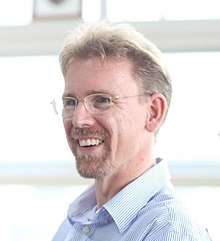Axel Timmermann
Axel Timmermann is a German climate physicist and oceanographer with an interest in climate dynamics, human migration, dynamical systems' analysis, ice-sheet modeling and sea level. He served a co-author of the IPCC Third Assessment Report[1] and a lead author of IPCC Fifth Assessment Report.[2] His research has been cited over 18,000 times and has an h-index of 70 and i10-index of 161.[3] In 2017, he became a Distinguished Professor at Pusan National University and the founding Director of the Institute for Basic Science Center for Climate Physics. In December 2018, the Center began to utilize a 1.43-petaflop Cray XC50 supercomputer, named Aleph, for climate physics research.[4][5][6][7]
Axel Timmermann | |
|---|---|
 | |
| Citizenship | Germany |
| Alma mater | University of Hamburg Philipp University of Marburg |
| Scientific career | |
| Fields | Climate dynamics, physical oceanography, dynamical systems' analysis, theoretical physics |
| Institutions | Institute for Basic Science Pusan National University University of Hawaii |
| Website | IBS Center for Climate Physics |
Education
He received a B.S. in physics and M.S. in theoretical physics in 1992 and 1995, respectively, from the University of Marburg in Germany. He worked as a research assistant for several years at the Max Planck Institute of Meteorology before completing a Ph.D. in meteorology in 1999 at the University of Hamburg.
Career
Timmermann worked as a postdoctoral fellow in the Netherlands and Hawaii before becoming a principal investigator of the DFG Research Group at the Institut fuer Meerskunde in Kiel. In 2004 he moved to Hawaii and worked as an Associate Professor and later Full Professor in the Department of Oceanography, School of Ocean and Earth Science and Technology, University of Hawaii. In 2017, he relocated to Busan, South Korea to head up the new IBS Center for Climate Physics in Pusan University. He has been a Clarivate Analytics Highly Cited Researcher in the cross-field category in 2018[8][9] and 2019.[10][11]
Honors and awards
- 2020: Commendation for Center for Climate Physics, Ministry of Science, ICT and Future Planning[12][13]
- 2018: Scientist of the Year Award, Korea Science Journalists Association[14][15]
- 2017: Milutin Milankovic Medal of the European Geosciences Union[16]
- 2015: Elected Fellow of the American Geophysical Union[17][18]
- 2015: University of Hawaii, Regents' Medal for Excellence in Research[19][20]
- 2007: Rosenstiel Award of the Rosenstiel School for Marine and Atmospheric Science (RSMAS), Miami[21][22]
- 2006: Rosenstiel Award for Outstanding Achievement and Distinction in Oceanographic Science, University of Miami Rosenstiel School of Marine & Atmospheric Science, Florida
References
- Griggs, David J.; Noguer, Maria, eds. (2001-07-12). Climate change 2001: The scientific basis. Contribution of Working Group I to the Third Assessment Report of the Intergovernmental Panel on Climate Change. Cambridge, United Kingdom and New York, NY, USA: Cambridge University Press. p. 892. ISBN 0521014956. Archived from the original on 2019-12-15. Retrieved 2017-12-06.
- Stocker, Thomas F.; Qin, Dahe, eds. (2014-03-24). Climate Change 2013: The Physical Science Basis: Working Group I Contribution to the Fifth Assessment Report of the Intergovernmental Panel on Climate Change. Cambridge, United Kingdom and New York, NY, USA: Cambridge University Press. p. 1,552. ISBN 978-1107661820.
- "Axel Timmermann - Google Scholar Citations". Google Scholar. Retrieved 6 March 2020.
- "Institute for Basic Science (IBS) - TOP500 Supercomputer Sites". TOP500. November 2018. Retrieved 28 November 2018.
- Feldman, Michael (20 September 2018). "Cray Picks Up Two Supercomputer Wins in Asia". TOP500. Retrieved 26 November 2018.
- "Cray XC50 Supercomputer coming to Institute for Basic Science in South Korea". www.InsideHPC.com. 20 September 2018. Retrieved 26 November 2018.
- "PNU's IBS Center for Climate Physics boosts climate research with new Supercomputing Facility". IBS Center for Climate Physics. Institute for Basic Science. Archived from the original on 26 November 2018. Retrieved 26 November 2018.
- "IBS Places First Among Korean Institutions by Featuring 9 Scientists in List of Highly Cited Researchers". Institute for Basic Science. 4 December 2018. Retrieved 12 February 2019.
- "Axel Timmermann gets selected as one of world's most Highly Cited Researchers". IBS Center for Climate Physics. 28 November 2018. Retrieved 1 November 2019.
- "Axel Timmermann selected as one of World's Most Highly Cited Researchers". IBS Center for Climate Physics. 21 November 2019. Retrieved 6 March 2020.
- "Seven IBS Scientists Named World's Most Highly Cited Researchers: Accounting for 13.1% of Korea's scientists on the list". Institute for Basic Science. 20 November 2019. Retrieved 6 March 2020.
- "ICCP awarded the Prize for Research Accomplishments and PR in Science Field by the Korean Government". IBS Center for Climate Physics. 29 February 2020. Retrieved 6 March 2020.
- 김, 태우 (5 March 2020). "IBS 기후물리 연구단, 과학기술정보통신부 장관표창 수상". 더리포트 (in Korean). Retrieved 6 March 2020.
- "Scientist of the Year Award from Korea Science Journalists Association". IBS Center for Climate Physics. 10 December 2018. Retrieved 1 November 2019.
- "과학언론상: 과학자상". Korea Science Journalists Association (in Korean). Retrieved 4 March 2020.
- "EGU - Awards & medals - Milutin Milankovic Medal - Axel Timmermann". European Geosciences Union. Retrieved December 6, 2017.
- Leinen, Leinen; Ravelo, Christina (28 July 2015). "2015 Class of AGU Fellows Announced - Eos". Eos. 96. doi:10.1029/2015EO033203.
- Bays, Brooks (31 July 2015). "Axel Timmermann elected American Geophysical Union Fellow - SOEST". School of Ocean and Earth Science and Technology. Retrieved 7 December 2017.
- "Regents' Medal for Excellence in Research - University of Hawaii System". University of Hawaii. Retrieved 7 December 2017.
- Bays, Brooks (29 April 2015). "Axel Timmermann - 2015 Regents' Medal for Excellence in Research - SOEST". School of Ocean and Earth Science and Technology. Retrieved 7 December 2017.
- "2007 Recipient - The Rosenstiel School of Marine and Atmospheric Science at the University of Miami". Rosenstiel School of Marine and Atmospheric Science. Archived from the original on 7 December 2017. Retrieved 7 December 2017.
- Kupec, Ivy; Colgan, Chuck (5 April 2007). "Understanding el Niño". Rosenstiel School of Marine and Atmospheric Science. Archived from the original on 21 September 2014. Retrieved 7 December 2017.